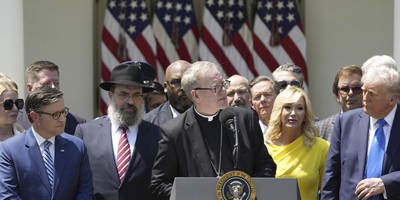The example I mentioned then was energy. For years, governments, national and local, have been promoting wind and solar power, to little practical effect. Curiously, the biggest wind power producer is Rick Perry's Texas. But wind power isn't reliable, and both wind and solar cause serious damage to the environment.
In the meantime, the oil and gas industries -- the favorite target of Barack Obama and congressional Democrats -- have developed new techniques of horizontal drilling and hydraulic fracturing (fracking) that have vastly expanded recoverable American energy supplies.
Now across my laptop comes news of another area in which private sector actors have overtaken government. Again an older technology has been improved and adapted to fill a need, while government dithers.
The old technology in this case is buses.
While the Obama administration has been desperately seeking to spend $53 billion on so-called high-speed rail lines, private businessmen have developed Chinatown and Megabus lines that provide inter-city service that has attracted legions of price-conscious travelers.
Chinatown bus service started in 1998 to provide a cheap way for Asian immigrants to get from New York to Boston. You lined up at the curb, paid your $20 fare to the driver and settled into a comfortable bus for four hours or so.
Now there's service to multiple destinations (including gambling casinos) from New York and on the West Coast, too. And competitors have arisen. Megabus routes exist between Maine and Memphis and Minneapolis, notably including many college towns.
The buses have bathrooms, AC power outlets and free wi-fi. They're not as fast as the much more expensive Acela train, but they tend to run on schedule.
Bus travel used to be decidedly downscale, with a clientele that scared off middle-class travelers. That's because, back in the days of heavily regulated transportation, bus lines followed the passenger railroad model, with stations in central cities, routes with multiple stops, fares propped up by monopolies and operators with no economic incentive to provide comfortable or pleasant service.
Recommended
Chinatown and Megabus operators ditched this model for one that works for travelers for whom money is scarce and time plentiful. Who needs a station? Intercity buses can occupy curb space briefly just as city buses do. Who needs multiple stops? You can make money on people who want to go from one specific location to another.
Needless to say, the cost to the taxpaying public is minimal. City streets and interstate highways already exist, and maintenance gets financing from gas taxes. And the system has enormous flexibility. If fewer passengers want to line up in Chinatown and more on the Upper West Side, the bus can change stops.
Private bus operators have effectively taken a 100-year-old technology, the bus, and adapted it seamlessly to the 21st century.
Compare high-speed rail. It is tethered to enormous stations that must be built or refurbished and limited to particular routes that, once the rails are laid down, cannot be changed except at prohibitive expense.
And it is enormously costly. In just two years, the estimated cost of the Obama administration's pet project, California high-speed rail, in the "flatter than Kansas" Central Valley has risen from $7.1 billion to $13.9 billion. Oxford economist Bent Flyvbjerg has found that high-speed rail projects always end up costing more, usually far more, than estimates.
In addition, operating costs almost always end up higher than fares. And fares always turn out to be expensive, comparable to airfare if you book a popular flight the day before your trip.
So high-speed rail is a form of transportation on which government subsidizes business travelers. You don't see backpackers anymore on the Acela or Amtrak trains from Washington to New York. They're taking the Chinatown bus or one of its competitors.
Finally, most of the high-speed rail lines the Obama administration is touting are a whole lot slower than France's TGV or Japan's bullet train. You can beat the proposed Minneapolis-Duluth line by going just slightly over the speed limit on I-35. The proposed line from the college town of Iowa City to Chicago would take longer than the currently operating bus service.
So the private sector provides cheap intercity transportation while government struggles to waste $53 billion. Please remind me which is the wave of the future.

























Join the conversation as a VIP Member